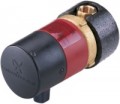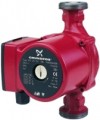Main function
The main application for which the pump is designed.
—
Central heating. By the name, pumps are designed to circulate the heating medium in the heating system. It avoids stagnation and ensures the efficiency and uniformity of heat transfer; without a pump, the circulation intensity would be insufficient due to the high hydro-resistance of the system. A mandatory feature of units for this purpose is the ability to operate at a high temperature of the pumped liquid (see below) — about 95 °C, or even more. Note that this allows the use of such pumps also in cold and hot water supply systems (see below); however, this can hardly be called the best option — models for heating usually cost more than other types due to high heat resistance and performance, and these are redundant in the DHW circuits.
—
DHW recirculation. Pumps whose task is to move water along the domestic hot water circuit. Such units are used in autonomous hot water systems — in other words, houses and apartments with their own water heaters. Constant circulation ensures uniform distribution of water throughout the circuit; in fact, this means that after opening the corresponding tap, you do not have to wait until hot water reaches the point of disassembly from the heater — it will immediately be hot. Like the central heating pumps (see above), DHW pumps can work with high-temperature water; however, for most models, the max
...imum temperature (see below) is 60 – 65 °C; therefore, such a unit cannot be installed in the heating system. At the same time, some exceptions can withstand up to 95 °C — they differ quite conditionally from heating pumps, mainly due to lower performance (usually less than 600 – 700 L/h). With cold water, models for this purpose usually cope without problems.
— TCold water pressure boost. Pumps are designed to provide additional pressure in the cold water circuit — for example, if the pressure in the water supply drops or if the main pump supplying the system with water does not reach the required pressure. The key difference of this type from the others described above is the low operating temperature (maximum — less than 60 °C) and, accordingly, the impossibility of working with hot water.
Many models allow use in other areas than those described above — for example, models for DHW recirculation may be suitable for operation in air conditioning or refrigeration systems.Max. flow
The maximum flow of a pump is the amount of liquid it can pump in a certain amount of time.
Features of choosing the optimal performance option depend primarily on the purpose of the pump (see above). For example, for DHW recirculation models, the pump performance should not exceed the performance of the water heater. If the water heater is capable of delivering 10 litres per minute to the DHW circuit, then the maximum pump performance will be 10*60=600 L/h. The basic formula for calculating the performance of a heating system takes into account the power of the heater and the temperature difference at the inlet and outlet, and for the cold water system — the number of points of water intake. More detailed information about the calculations for each application can be found in special sources, and it is better to entrust the calculations themselves to professionals.
Max. head
The head can be described as the maximum height to which a pump can lift liquid through a vertical pipe without bending or branching. This parameter is directly related to the pressure that the pump produces: 10 m of head approximately corresponds to a pressure of 1 bar (do not confuse this parameter with operating pressure — see more about it below).
The head is one of the key specs for most circulation pumps. Traditionally, it is calculated based on the difference in height between the location of the pump and the highest point of the system; however, this principle is relevant only for units that
boost the pressure of cold water(see "Suitable for"). Circulation pumps for heating and DHW work with closed circuits, and the optimal pressure depends on the total hydraulic resistance of the system. Detailed calculation formulas for the first and second cases can be found in special sources.
Max. fluid temperature
The highest liquid temperature that the pump is capable of operating normally.
The possibility of using the unit directly depends on this parameter (see "Suitable for"): for example, models for heating systems must tolerate a temperature of at least 95 °C, and for DHW supply — at least 65 °C. Well, anyway, this parameter should not be exceeded: an overheated pump will fail very quickly, and the consequences of this can be very unpleasant.
Features
— Number of speeds. The number of speeds provided in the design of the pump. Each speed corresponds to its performance value (see above). The options could be:
- 1 speed. There are no adjustments in such models; when turned on, the pump can operate only at one speed. This is the simplest and most inexpensive option, due to the absence of additional elements (regulators) in the design. Of course, it is convenient only in cases where the unit must operate at full capacity every time it is turned on.
- 2 speeds. 2 speeds give the user some degree of choice: the pump does not have to be turned on at full power — when it is not required, the unit can be run at reduced power to save electricity and not wear out the mechanisms beyond what is necessary.
- 3 speeds. The largest number of adjustments found in modern pumps — it makes no sense to provide a larger number for many reasons. It gives even more options for setting operation parameters than 2 speeds.
- Stepless adjustment. This option implies the ability to set the regulator to any position from minimum to maximum (in some models, fixed settings may also be provided, but only as an additional option). It provides maximum freedom and precision in the choice of operating mode. However, it significantly affects the price; and the real need for smooth adjustment occurs quite rarely.
—
Automatic operating mode.... The essence of this function differs depending on the purpose of the device (see above). So, in models for increasing the pressure of cold water, the automation turns on the pump when the tap is opened and turns it off when it is closed — a special sensor reacts to the movement of water. In models for heating and domestic hot water, automation is responsible for adjusting the operating parameters — for example, when screwing the valves and reducing the flow rate, the pump can reduce the pressure, as well as, for additional functions, such as an on-off timer. Anyway, this feature makes life easier for the user, eliminating the need to perform certain operations manually and adding new features to the pump; but the specific set of these features depends on the model.
— Display. Various additional information can be displayed on the display: operating mode, performance settings, water temperature, set timers, error messages and much more. It makes management more convenient and intuitive. Pumps usually use the simplest form of black and white LCD screens, but this is quite sufficient for the purposes mentioned.
— Control panel. In this case, the control panel means a panel that has a switch with a choice of operating modes between automatic (see above) and manual. Accordingly, the presence of several modes almost necessarily means the presence of a control panel. But the speed switches themselves are not considered for this function.Max. power consumption
The electrical power consumed by the pump during normal operation and maximum performance.
This indicator directly depends on performance — after all, for pumping large volumes of water, an appropriate amount of energy is needed. And the power depends on two main parameters — electricity consumption and the load on the power grid, which determines the connection rules. For example, pumps with a power of more than 5 kW cannot be connected to ordinary household sockets; more detailed rules can be found in special sources.
Inlet
The size of the inlet provided in the design of the pump. For plumbing threads (see Connection), the size is traditionally indicated in inches and fractions of an inch (for example, 1" or 3/4"), for flanges, the nominal diameter (DN) of the bore in millimetres is used — for example, DN65.
This parameter must match the dimensions of the mount on the pipe to which the pump is planned to be connected — otherwise, you will have to use adapters, which is not very convenient, and sometimes not recommended at all.
Outlet
The size of the outlet provided in the design of the pump. The value of this parameter is completely similar to the size of the inlet (see above).
Pump housing material
It is the material from which the outer part of the pump housing is made.
—
Stainless steel. As the name suggests, stainless steel is virtually corrosion-resistant. However, this is not its only advantage — this material is very durable and reliable, due to which it is used even in powerful high-performance models.
—
Cast iron. This material is in many ways similar to steel — in particular, it is considered very reliable — but it has a slightly higher weight. On the other hand, in most cases, this is not a noticeable drawback, but cast iron costs a little cheaper than stainless steel.
—
Brass. An alloy based on copper and zinc, which has a golden colour. The varieties used in circulation pumps are highly resistant to corrosion and even surpass stainless steel. Therefore, this option is well suited for water with a high oxygen content. The disadvantage of brass can be called a higher cost than that of the same steel.
—
Bronze. Another copper-based alloy. According to the main features, this material is similar to the brass described above.
— Plastic. Units with plastic housings are lightweight, inert to water, and completely unaffected by corrosion. Moreover, polymer materials allow almost any thickness of the body, which determines the requirements of the mould for casting the workpiece. The di
...sadvantage of plastic is its low mechanical strength. The plastic housing can be damaged on the outside and outside due to any kind of impact.
